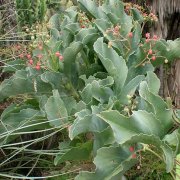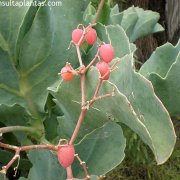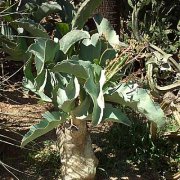Care of the succulent plant Cyphostemma juttae or Wild grape |
|
The genus Cyphostemma, family Vitaceae, includes about 250 species of caudiciform plants native to Africa. Some species are: Cyphostemma juttae, Cyphostemma elephantopus, Cyphostemma bainesii, Cyphostemma currorii. Common names: Wild grape, Tree grape, Namibian grape, Elephant's Foot, Butter bush, Bastard cobas, Droog-my-keel, Blue kobas. This species is native to Namibia. They are deciduous succulent plants of arboreal size and slow growth that reach 2 meters (6.56 feet) in height. The thick trunk is covered with whitish bark. The large, fleshy leaves are oval in shape, glossy green in color, and have toothed margins. The flowers have no decorative interest. The showy poisonous red fruits appear in late summer. Wild grape is used as isolated specimens, in small groups, in rockeries and in pots for patios and terraces. Cyphostemma juttae needs full sun exposure and a hot, dry climate. It resists light and occasional frosts. Namibian grape grows in well-drained sandy or clay soils. If grown in a pot, use a commercial cactus substrate with 20% coarse sand. Tree grape is a very resistant to drought plant that need moderate irrigation waiting for the substrate to be completely dry. Do not water in winter. Fertilize in spring with algae extract. Elephant's Foot does not need pruning. Cyphostemma juttae is a very sensitive plant to excess moisture, especially in winter. Butter bush is propagated from seeds sown in spring and by cuttings in late summer. |
Images of the succulent plant Cyphostemma juttae or Wild grape |
Find plants
Cyphostemma juttae or Wild grape | Care and Growing
© 2025 FavThemes


